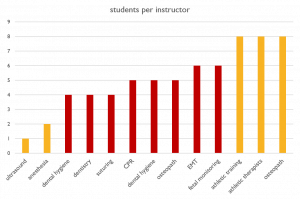Ratios depend on learner level and skill taught
Generally, novice learners need more supervision than more experienced learners.
Snider et al reviewed actual instructor numbers in a variety of training programs. The data from that study is graphed below. In studies on veterinary skills teaching, 1:3 was effective in live animal labs while 1:4 was good for skills practice. For most veterinary training programs, the ratio should likely be between 1:4 and 1:6. Ratios of 1:8 may be acceptable for more experienced learners. For more specialty surgery training, 1:2 led to more confidence and practice than 1:4.

1:2 is a good starting point
Students learn best when working with a peer at the same level of performance. Students working pairs verbalize steps, talk about error prevention, and share cognitive load. One instructor working with two students is the most efficient ratio for quality learning. There was no advantage to adding a third student.
Organizing the instructors
There appears to be a slight advantage to assigning instructors to specific groups of students. In one study, students learned better with consistent (non-contradictory) feedback (JVME 2014). In another study, students did not notice a difference but instructors could more readily identify struggling learners (JVME 2019).
Resources
Williamson et al. A Randomized Trial Comparing Freely Moving and Zonal Instruction of Veterinary Surgical Skills Using Ovariohysterectomy Models. JVME 46(2):195, 2019
Dort et al. Hands-on 2.0: improving transfer of training via the Society of American Gastrointestinal and Endoscopic Surgeons (SAGES) Acquisition of Data for Outcomes and Procedure Transfer (ADOPT) program. Surgical Endoscopy, 2017, Vol.31(8), pp.3326-3332
Freeman et al. Teaching Veterinary Anesthesia and Surgery: The Impact of Instructor Availability on Anesthesia, Operative, and Recovery Times in Dogs Undergoing Ovariohysterectomy or Castration. JVME 41(4):390-399, 2014
Martineau et al. To observe or not to observe peers when learning physical examination skills, that is the question. BMC Medical Education 2013, 13:55
Snider et al. Trainer-to-Student Ratios for Teaching Psychomotor Skills in Health Care Fields, as Applied to Osteopathic Manipulative Medicine. J Am Osteopath Assoc. 2012;112(4):182-187
Dubrowski and MacRae. Randomised, controlled study investigating the optimal instructor: student ratios for teaching suturing skills. Medical Education 2006; 40: 59–63

